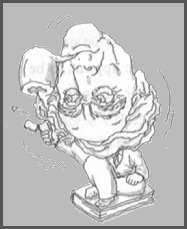 (ケンブリッジ大学の)春学期が終わると,アリスと私はファーンハーストに戻り,そこで数学の論理的導出(論理学から数学を演繹・導出) --後に『プリンキピア・マテマティカ』となったもの-- を書き上げる仕事に着手した。その仕事も,ほぼ終了したと私は考えていたが,5月になって,同じ年(1901年)の2月に起こった感情的な後退(注:妻アリスに愛情を持てなくなったこと)とほとんど同じくらい酷い知的後退があった。カントール(Georg Cantor, 1845-1918)は,’最大の数は存在しない’という証明をしていた。(しかし)私には,(当時)世界に存在するあらゆるものの数(世界に存在するすべてのものを合計した数)は,可能な最大の数であるはずだと思われた。そこで私は,彼の証明をいくらか詳細に吟味した。そうして,それを存在する全てのものの集合(クラス)に適用しようと努めた。それによって,自己自身の要素でないところの諸集合(クラス)について検討するとともに,そのような集合の集合が,はたしてそれ自身の要素であるか否かについて問わなければならなくなった。私は,その答え(要素であるという答えと要素でないという答え)のいずれも矛盾に陥ることを発見した。当初私は,その矛盾(論理的パラドクス)はきわめて容易に克服できるだろう,また,推論のうちに何かつまらぬ誤りがあるに違いない,と思った。しかし,徐々にそうではないことが明らかになった。ブラリ・フォルティ(Cesare Burali Forti(ブラリ・フォルティ), 1861-1931: イタリアの論理学者。 )もすでに同様の矛盾を発見しており,それは,論理分析において,クレタ人であるエピメニデス(Epimenides, 生没年不詳。ギリシア七賢人の一人で,クレタ島生まれ)が,「すべてのクレタ人は嘘つきである」と言った古代ギリシアの’矛盾’と類似したものであることが明らかになった。本質的にエピメニデスの矛盾と同様の矛盾は,「この紙の裏面に述べられていることは誤りである。」と書かれた紙を人に渡すことによって創り出せる。その人が今度はその紙を裏返せば,紙の裏面には,「この紙の裏面(即ちさきほどの表面)に書かれていることは正しい」と書いてあるのを発見する。大人がそのようなとるに足らないことに時間を費やす価値はないように思われたが,しかしそれなら私は一体何をすればよかったのか。そのような矛盾が通常の(正規の)諸前提から避けられないのであるなら,何かがまちがっていたのである。つまらないものであろうとなかろうと,この問題は(私に対する)1つの挑戦であった。1901年の後半いっぱい,この問題の解決は容易であろうと思っていた,1901年末になって,それは大仕事であるという結論に達した。そこで私は,その解決を一時とりやめて,(まず)『数学の原理』(The Principles of Mathematics)を終えてしまおうと決心した。記号論理学の講義を2学期に渡ってするように(トリニティ・コレッジから)招請を私は受けていたので,アリスと私は,その年の秋,ケンブリッジに戻った。その講義には,後に『プリンキピア・マテマティカ』の概要を含んでいたが,私は,(数理論理学における)矛盾を取り扱う方法については,いっさいふれなかった。
(ケンブリッジ大学の)春学期が終わると,アリスと私はファーンハーストに戻り,そこで数学の論理的導出(論理学から数学を演繹・導出) --後に『プリンキピア・マテマティカ』となったもの-- を書き上げる仕事に着手した。その仕事も,ほぼ終了したと私は考えていたが,5月になって,同じ年(1901年)の2月に起こった感情的な後退(注:妻アリスに愛情を持てなくなったこと)とほとんど同じくらい酷い知的後退があった。カントール(Georg Cantor, 1845-1918)は,’最大の数は存在しない’という証明をしていた。(しかし)私には,(当時)世界に存在するあらゆるものの数(世界に存在するすべてのものを合計した数)は,可能な最大の数であるはずだと思われた。そこで私は,彼の証明をいくらか詳細に吟味した。そうして,それを存在する全てのものの集合(クラス)に適用しようと努めた。それによって,自己自身の要素でないところの諸集合(クラス)について検討するとともに,そのような集合の集合が,はたしてそれ自身の要素であるか否かについて問わなければならなくなった。私は,その答え(要素であるという答えと要素でないという答え)のいずれも矛盾に陥ることを発見した。当初私は,その矛盾(論理的パラドクス)はきわめて容易に克服できるだろう,また,推論のうちに何かつまらぬ誤りがあるに違いない,と思った。しかし,徐々にそうではないことが明らかになった。ブラリ・フォルティ(Cesare Burali Forti(ブラリ・フォルティ), 1861-1931: イタリアの論理学者。 )もすでに同様の矛盾を発見しており,それは,論理分析において,クレタ人であるエピメニデス(Epimenides, 生没年不詳。ギリシア七賢人の一人で,クレタ島生まれ)が,「すべてのクレタ人は嘘つきである」と言った古代ギリシアの’矛盾’と類似したものであることが明らかになった。本質的にエピメニデスの矛盾と同様の矛盾は,「この紙の裏面に述べられていることは誤りである。」と書かれた紙を人に渡すことによって創り出せる。その人が今度はその紙を裏返せば,紙の裏面には,「この紙の裏面(即ちさきほどの表面)に書かれていることは正しい」と書いてあるのを発見する。大人がそのようなとるに足らないことに時間を費やす価値はないように思われたが,しかしそれなら私は一体何をすればよかったのか。そのような矛盾が通常の(正規の)諸前提から避けられないのであるなら,何かがまちがっていたのである。つまらないものであろうとなかろうと,この問題は(私に対する)1つの挑戦であった。1901年の後半いっぱい,この問題の解決は容易であろうと思っていた,1901年末になって,それは大仕事であるという結論に達した。そこで私は,その解決を一時とりやめて,(まず)『数学の原理』(The Principles of Mathematics)を終えてしまおうと決心した。記号論理学の講義を2学期に渡ってするように(トリニティ・コレッジから)招請を私は受けていたので,アリスと私は,その年の秋,ケンブリッジに戻った。その講義には,後に『プリンキピア・マテマティカ』の概要を含んでいたが,私は,(数理論理学における)矛盾を取り扱う方法については,いっさいふれなかった。
 At the end of the Lent Term, Alys and I went back to Fernhurst, where I set to work to write out the logical deduction of mathematics which afterwards became Principia Mathematica. I thought the work was nearly finished, but in the month of May I had an intellectual set-back almost as severe as the emotional set-back which I had had in February. Cantor had a proof that there is no greatest number, and it seemed to me that the number of all the things in the world ought to be the greatest possible. Accordingly, I examined his proof with some minuteness, and endeavoured to apply it to the class of all the things there are. This led me to consider those classes which are not members of themselves, and to ask whether the class of such classes is or is not a member of itself. I found that either answer implies its contradictory. At first I supposed that I should be able to overcome the contradiction quite easily, and that probably there was some trivial error in the reasoning. Gradually, however, it became clear that this was not the case. Burali-Forti had already discovered a similar contradiction, and it turned out on logical analysis that there was an affinity with the ancient Greek contradiction about Epimenides the Cretan, who said that all cretans are liars. A contradiction essentially similar to that of Epimenides can be created by giving a person a piece of paper on which is written: ‘The statement on the other side of this paper is false.’ The person turns the paper over, and finds on the other side: ‘The statement on the other side of this paper is true’. It seemed unworthy of a grown man to spend his time on such trivialities, but what was I to do? There was something wrong, since such contradictions were unavoidable on ordinary premisses. Trivial or not, the matter was a challenge. Throughout the latter half of 1901 I supposed the solution would be easy, but by the end of that time I had concluded that it was a big job. I therefore decided to finish The Principles of Mathematics, leaving the solution in abeyance. In the autumn Alys and I went back to Cambridge, as I had been invited to give two terms’ lectures on mathematical logic. These lectures contained the outline of Principia Mathematica, but without any method of dealing with the contradictions.
At the end of the Lent Term, Alys and I went back to Fernhurst, where I set to work to write out the logical deduction of mathematics which afterwards became Principia Mathematica. I thought the work was nearly finished, but in the month of May I had an intellectual set-back almost as severe as the emotional set-back which I had had in February. Cantor had a proof that there is no greatest number, and it seemed to me that the number of all the things in the world ought to be the greatest possible. Accordingly, I examined his proof with some minuteness, and endeavoured to apply it to the class of all the things there are. This led me to consider those classes which are not members of themselves, and to ask whether the class of such classes is or is not a member of itself. I found that either answer implies its contradictory. At first I supposed that I should be able to overcome the contradiction quite easily, and that probably there was some trivial error in the reasoning. Gradually, however, it became clear that this was not the case. Burali-Forti had already discovered a similar contradiction, and it turned out on logical analysis that there was an affinity with the ancient Greek contradiction about Epimenides the Cretan, who said that all cretans are liars. A contradiction essentially similar to that of Epimenides can be created by giving a person a piece of paper on which is written: ‘The statement on the other side of this paper is false.’ The person turns the paper over, and finds on the other side: ‘The statement on the other side of this paper is true’. It seemed unworthy of a grown man to spend his time on such trivialities, but what was I to do? There was something wrong, since such contradictions were unavoidable on ordinary premisses. Trivial or not, the matter was a challenge. Throughout the latter half of 1901 I supposed the solution would be easy, but by the end of that time I had concluded that it was a big job. I therefore decided to finish The Principles of Mathematics, leaving the solution in abeyance. In the autumn Alys and I went back to Cambridge, as I had been invited to give two terms’ lectures on mathematical logic. These lectures contained the outline of Principia Mathematica, but without any method of dealing with the contradictions.
出典: The Autobiography of Bertrand Russell, v.1, chap. 6: Principia Mathematica, 1967]
詳細情報:http://russell-j.com/beginner/AB16-050.HTM
[寸言]
このラッセルのパラドクスがわかりにくいようであれば、三浦俊彦『ラッセルのパラドクス』(岩波新書)をお読みください。この本は、ラッセルのパラドクスだけでなく、ラッセルの論理学全体を扱っており、大変参考になります。
